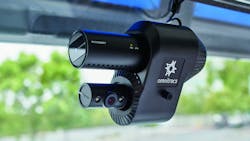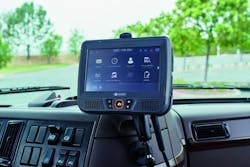Another take on driver-facing cam in Omnitracs' new video product
With Omnitracs' just-announced Critical Event Video (CEV) product, there's a subtle feature with the optional driver-facing camera that the fleet management systems company says can help gain drivers' buy-in.
A driver-facing camera can sometimes be a point of contention for commercial truck drivers when fleets choose to add video to their trucks, with drivers feeling it's a trust and privacy issue. The solution Omnitracs has devised for CEV — which features front-facing and optional driver-facing video — is to link the driver-facing video to Omnitracs Hours of Service, so it records only when a driver is on duty.
"Drivers absolutely matter, and their right to privacy is a concern that we know our customers want to be able to fully address," Drew Schimelpfenig, the company's safety product management and integrations manager, tells Fleet Owner. "We can provide drivers with the capability to turn off the driver-facing recording and all audio recording when they are ready to move to 'Off Duty' or 'Sleeper' [status]."
In a release, Omnitracs describes the new CEV as "the only in-vehicle video solution fully integrated with Omnitracs' Critical Event Reporting," which matches CEV's front-facing and optional driver-facing video with triggering factors like hard braking, collision warning/mitigation or speeding. CEV also includes time, location and the truck's actual speed when video is triggered.
"Videos produced by CEV will be hosted by Critical Event Reporting and available for review, and videos that were not originally triggered by a critical event can be requested by date and time," Schimelpfenig explains, so users can view video from a particular time regardless of adverse event indicators. "Customers have between three to five days, depending on configurations, to request a video from the vehicle and up to 30 days to view and download any videos that have already been sent from the vehicle within Critical Event Reporting."
He contends also that CEV's integration with Omnitracs fleet management platforms makes it more cost-effective and gives it a readily familiar interface for Omnitracs customers. "Critical Event Video is absolutely intended to be a fully integrated solution within the current suite of products and applications being used by Omnitracs customers. They won't need to learn an entirely new application, maintain additional user security and wonder if their investment in software is being leveraged," Schimelpfenig says.
"The ease of use and consistency with existing procedures that already include Critical Event Reporting are now very simply enhanced with the addition of video," he adds.
Omnitracs CEV video segments can be expanded using a prequel/sequel feature that adds 30-sec. clips before and afterward, providing up to 240 seconds for each event. "This allows customers to go back or forward in time to see additional video that can tell the rest of the story of what really was the cause or outcome of an incident," Schimelpfenig says. "The resulting video is automatically saved with the critical event and available for replay according to retention policy, and can be downloaded as an MP4 along with any additional information from the event in Critical Event Reporting."
About the Author
Aaron Marsh
Aaron Marsh is a former senior editor of FleetOwner, who wrote for the publication from 2015 to 2019.

